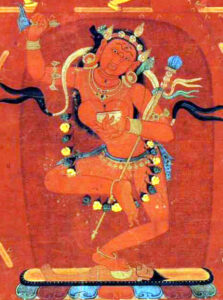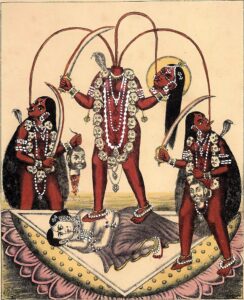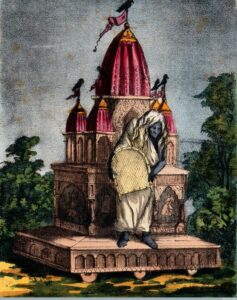Chhinnamasta
 Chhinnamasta is the thunderbolt, the streak of lightening, which is the Shakti of Virocana, the Supreme Self, the luminosity of the Primordial Prakasa. That is why she is Vajravairocani, the glow of the Paramatma which flashes like a lightening and shatters the skies. She is yellow and shines like a million suns, the glory of which destroys all desires and makes her a Mahayogini, the supreme exponent of yogic powers and like Vajra, pure and blazing. She epitomizes self-control by conquering sexual and selfish desires and transforming that energy into yogic energy. Hence she is Yogamaya, Yogamargapradyini, the acme of yogic force. The blood rushing from below her feet to her head depicts this transformation of kunadalini energy from its somnabulence to its blossoming through the dint of yoga and the act of self control. Be the energy below the control of sexual desire of Rati and Karma, or the transformation of the eternal yearning for Shiva under her feet, both are channelized into a blazing, yogic might, which makes her like the Vajra, untainted and pure. This primal energy rushes up her body to meet the thousand petalled lotus in her head, culminating in the bliss of the union with Parama Shiva. Hence she is the epitome of spiritual power which every sadhaka seeks to acquire.
Chhinnamasta is the thunderbolt, the streak of lightening, which is the Shakti of Virocana, the Supreme Self, the luminosity of the Primordial Prakasa. That is why she is Vajravairocani, the glow of the Paramatma which flashes like a lightening and shatters the skies. She is yellow and shines like a million suns, the glory of which destroys all desires and makes her a Mahayogini, the supreme exponent of yogic powers and like Vajra, pure and blazing. She epitomizes self-control by conquering sexual and selfish desires and transforming that energy into yogic energy. Hence she is Yogamaya, Yogamargapradyini, the acme of yogic force. The blood rushing from below her feet to her head depicts this transformation of kunadalini energy from its somnabulence to its blossoming through the dint of yoga and the act of self control. Be the energy below the control of sexual desire of Rati and Karma, or the transformation of the eternal yearning for Shiva under her feet, both are channelized into a blazing, yogic might, which makes her like the Vajra, untainted and pure. This primal energy rushes up her body to meet the thousand petalled lotus in her head, culminating in the bliss of the union with Parama Shiva. Hence she is the epitome of spiritual power which every sadhaka seeks to acquire.  The energy is also channelized into love as the blood nourishes her devotees on her either side, who were hungry for nourishment. So she is the food (bhojanam), the nourisher (bhokta) and the eater (bhojyam) as she also drinks her own blood while feeding her devotees. These two devotees are Rajas and Tamas, who could not escape the bind of duality, and are therefore fed by the secondary channels or nadis, Ira and Pingala. Thus they are also known by these names. The Devi as the Sushumna, depicts Satva guna and she is the one who is able to cut the binds of the chakras and clear the passage for the blood to rush though and unite with Shiva in the sahasrara and then gush down to drench the sadhaka in the bliss of the union. As the destroyer of all bonds, and the means of achieving liberation through supreme yogic powers, Chhinnamasta is the embodiment of Moksha. Rahu, the greatest of bonders, the cause of re-birth, grips the sadhaka in its vicious coils. From its basest form of extreme greed and carnal desires, through the treachery and trickery of its twisted mind, it seeks to engulf all that comes before his path. Even when a person is able to avoid such engulfment, it ensures that his path towards the union with Parama Shiva is strewn with hurdles and makes it difficult for the sadhaka to prise himself from his grasp. It is Chhinnamasta who has the power to cut the knots of Rahu and release the sadhaka from his bonds to enable
The energy is also channelized into love as the blood nourishes her devotees on her either side, who were hungry for nourishment. So she is the food (bhojanam), the nourisher (bhokta) and the eater (bhojyam) as she also drinks her own blood while feeding her devotees. These two devotees are Rajas and Tamas, who could not escape the bind of duality, and are therefore fed by the secondary channels or nadis, Ira and Pingala. Thus they are also known by these names. The Devi as the Sushumna, depicts Satva guna and she is the one who is able to cut the binds of the chakras and clear the passage for the blood to rush though and unite with Shiva in the sahasrara and then gush down to drench the sadhaka in the bliss of the union. As the destroyer of all bonds, and the means of achieving liberation through supreme yogic powers, Chhinnamasta is the embodiment of Moksha. Rahu, the greatest of bonders, the cause of re-birth, grips the sadhaka in its vicious coils. From its basest form of extreme greed and carnal desires, through the treachery and trickery of its twisted mind, it seeks to engulf all that comes before his path. Even when a person is able to avoid such engulfment, it ensures that his path towards the union with Parama Shiva is strewn with hurdles and makes it difficult for the sadhaka to prise himself from his grasp. It is Chhinnamasta who has the power to cut the knots of Rahu and release the sadhaka from his bonds to enable  his journey towards Moksha. Chhinnamasta therefore is the link, which allows one to travel the trajectory from Rahu (bondage) to Ketu (liberation), wherein all desires are dissolved. Having cut the bonds, Devi herself absorbs the poison and transforms herself to Dhoomavati, the ugly, toothless, crooked nosed, crow riding Widow Goddess, for only She has the power and magnanimity to hold both the poison and the nectar. Hence Dhoomavati is black, as she depicts dissolution at the time of pralaya, represents all that is inauspicious, embodies social rejection and grants even evil desires, for having absorbed Rahu, Dhoomavati displays the traits of the feared node. In many instances, Dhoomavati is said to enjoy alcohol and lust after sexual pleasures, all of which are distinct Rahuvian characteristics. Indeed, as the Mahavidya deity for mokshakaraka Ketu, Dhoomvati embodies Rahu by absorbing all its desires, and Chhinnamasta as the one who has the potential of liberating Rahu, portrays the qualities of Ketu. This transference of physicality of the two goddesses exhibits the dyadic quality of Rahu and Ketu, at once interdependent and inseparable. Devi therefore shows the way along the path of the nodal axis, that is man’s journey on this earth: as Chhinnmasta, cutting the Gordian knots of Rahu and then as Dhoomavati, absorbing those desires, and when the sadhaka realises that Chhinnamasta and Dhoomavati are one and the same, he transcends the nodes and merges with the Paramatma.
his journey towards Moksha. Chhinnamasta therefore is the link, which allows one to travel the trajectory from Rahu (bondage) to Ketu (liberation), wherein all desires are dissolved. Having cut the bonds, Devi herself absorbs the poison and transforms herself to Dhoomavati, the ugly, toothless, crooked nosed, crow riding Widow Goddess, for only She has the power and magnanimity to hold both the poison and the nectar. Hence Dhoomavati is black, as she depicts dissolution at the time of pralaya, represents all that is inauspicious, embodies social rejection and grants even evil desires, for having absorbed Rahu, Dhoomavati displays the traits of the feared node. In many instances, Dhoomavati is said to enjoy alcohol and lust after sexual pleasures, all of which are distinct Rahuvian characteristics. Indeed, as the Mahavidya deity for mokshakaraka Ketu, Dhoomvati embodies Rahu by absorbing all its desires, and Chhinnamasta as the one who has the potential of liberating Rahu, portrays the qualities of Ketu. This transference of physicality of the two goddesses exhibits the dyadic quality of Rahu and Ketu, at once interdependent and inseparable. Devi therefore shows the way along the path of the nodal axis, that is man’s journey on this earth: as Chhinnmasta, cutting the Gordian knots of Rahu and then as Dhoomavati, absorbing those desires, and when the sadhaka realises that Chhinnamasta and Dhoomavati are one and the same, he transcends the nodes and merges with the Paramatma.
![]()

0 comments